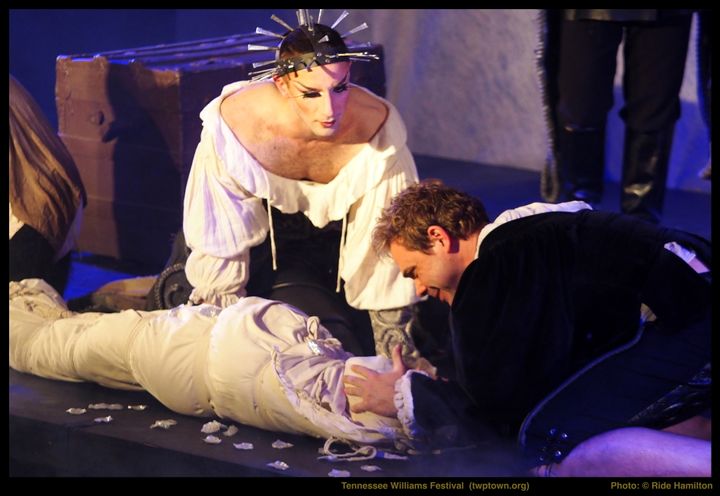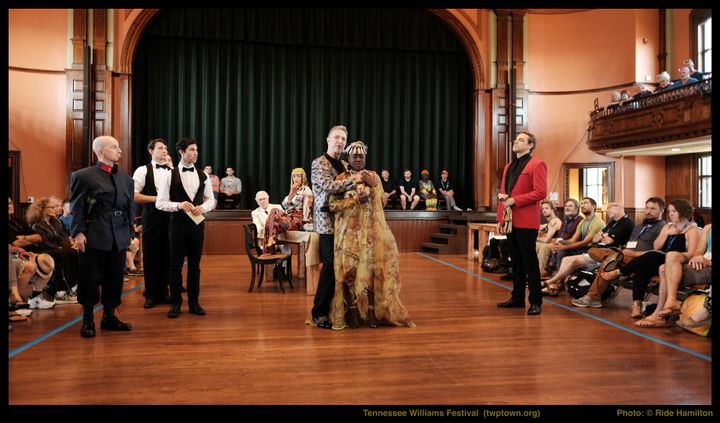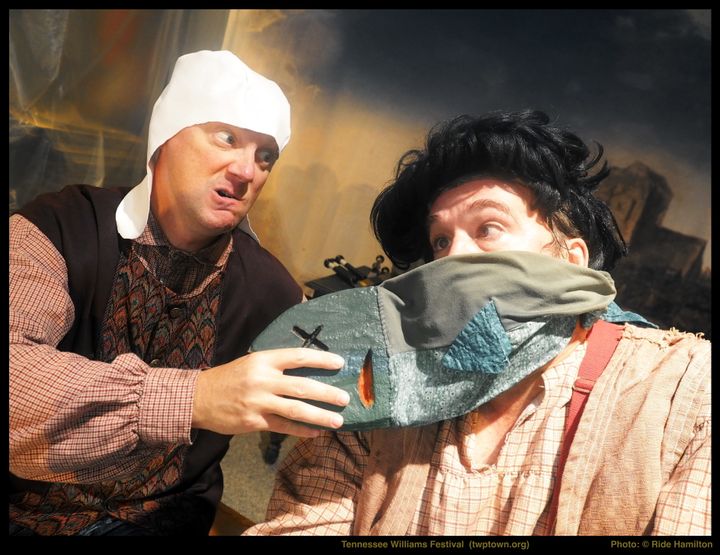NB: This is the second of a three part series on the Provincetown Tennessee Williams Theater Festival. To read Part 1, containing reviews of Ten Blocks on the Camino Real and The Gnädiges Fräulein, click here, and Part 2, containing reviews of Sweet Bird of Youth, Pericles, and The Hotel Plays, click here.

(l to r) Callum Tilbury as Gertrude and Marcel Meyer as Hamlet in Abrahamse & Meyer Productions’s Hamlet, by William Shakespeare.
Hamlet
When I think of Hamlet, a particular image comes to mind: a figure in puffy sleeves holding a skull with the legend “To be, or not to be” written beneath it. The legend should read “Alas, poor Yorick,” which is why I think it is a fitting, if incorrect, representation of most interactions one has today with this famous play. Most people have seen a passable production, but few have witnessed its full glory in live performance. I thought I had seen a decent Hamlet before, but Abrahamse & Meyer Production’s Hamlet made my other viewing experience seem amateur by comparison. The excellent performances, innovative interpretations of the text, and bold design choices all came together to create a transcendent production that I will not soon forget.
From the start, the stage and moat set that was not fully motivated for Sweet Bird of Youth here created an atmosphere both rich in symbols and neutral enough to allow the actors to shine. Fred Abrahamse served as the set and lighting designer as well as the director, and the unified theory of this production was beautifully realized in performance. The play was performed as written, with two important exceptions: it began with Marcel Meyer handing out parts to the actors while giving Hamlet’s instructions to the troupe speech about performance, and the later scene concerning the troupe gave way to Gertrude and Claudius being forced to read the play together. I found these changes worked very well, as it gave the play a metatheatrical bent at the start, while also increasing the aggressive prod at Hamlet’s mother and uncle/stepfather in the course of the play.
Meyer, who was playing no fewer than three major parts during various shows throughout the Festival, was a phenomenal Hamlet, able to play Hamlet’s idealism and his simultaneously honorable and obsessive drive for justice. None of the women in this play were cast as female actors, and yet I found myself seeing these women very clearly. Matthew Baldwin’s Ophelia was lovelorn, but also defiant before her eventual downfall. But the performance that made me look at the play in a way I never had before came from Callum Tilbury, whose Gertrude had more depth than any I’d ever seen before.
I have always seen Gertrude played as someone who is trying to keep silent and neutral to keep the peace, yet Tilbury’s Gertrude was actively negotiating emotional truth and polite decorum. Tilbury’s performance was so far from camp that it made me long to see him as Candy in Tennessee Williams’s one-act And Tell Sad Stories of the Death of Queens...Gertrude’s bedchamber scene with Hamlet was dynamic, tension-filled, and heartbreaking, with the dramatic makeup streaking down Tilbury’s face as Gertrude comes to terms with what Hamlet reveals to her. As you can see from the photo above, Gertrude’s gorgeous, yet menacing crown was a stunning costume piece, one of many that Meyer also designed.
The rest of the cast were excellent as well, with Dean Balie playing up the humorous parts of Polonius, which had the audience laughing out loud. Jeremy Richard’s Laertes was a great foil to Meyer’s Hamlet, especially in the literal sense during the fight scene. I need to take a moment to commend Fight Director Anton Moon for including true fight choreography that brought tremendous excitement to this scene. Last, but certainly not least, Michael Richard’s Claudius walked the fine line between power-hungry villain and concerned parent with a delicacy that made me reconsider his character as well. The strength of this production is what I have come to expect from this talented company, and I greatly look forward to my next opportunity to see them perform.

(l to r) Everett Quinton, Kyle Blanchette, Joel DeCandio, Bill Salem, Selim Galip, Robertson Dean, Abena Takyi, and Marcel Meyer in David Kaplan’s special production of The Tragedie of Anthonie, and Cleopatra (Part 1), by William Shakespeare.
The Tragedy of Anthonie, and Cleoopatra (Part 1)
For one single performance during the 2017 Provincetown Tennessee Williams Theater Festival, actors from all of the companies from a variety of different countries came together with additional actors from further countries to present an international staging of part of Antony & Cleopatra, directed by David Kaplan. The piece was amazing in scale, and was performed with three different Cleopatras, not counting Marcel Meyer’s momentary stepping-in as both Cleopatra and Antony at various moments.
There were so many wonderful things about this grand theatrical hybrid, and yet the space of Town Hall took away some of the experience by drowning the actors’ lines with its difficult acoustics. Despite the challenge, the very Brechtian nature of the staging managed to incorporate it, as the recognition of the actors performing and watching a performance brought an added layer to the text.
In addition to the hard-working Marcel Meyer in his third production for the Festival (in addition to playing Chance in Sweet Bird and the titular role in Hamlet), it was a pleasure to see Abena Takyi (Marguerite in Ten Blocks at the Camino Real) take her turn as Cleopatra, and witness the return of Robertson Dean (last year’s director and lead in Kirche, Küche, Kinder) as Marc Antony. Downtown theatrical persona Everett Quinton, who directed In the Bar of a Tokyo Hotel last year, returned to the stage in a dual role as Domitius Enobarbus and Cleopatra, and Turkish actor Meltem Keskin Bayur rounded out the tripled Cleopatras.
The program note points to the ever-shifting image of Cleopatra, as evidenced by the ways in which she asked to be represented in art and sculpture within her lifetime. Kaplan’s production successfully brought out several different aspects of Cleopatra in different portions of the text. Takyi’s Cleopatra was a sultry, empowered, clever woman in love, playing up the romance with Antony as she woos him. Bayur’s Cleopatra was next, showcasing a the worldly leader who has seen a great deal and has a sense of humor about the world. And, finally, Quinton’s campy Cleopatra was the larger than life diva that overshadows any actual historical figure. All of these actors brought tremendous things to the role, and it was especially wonderful to see Quinton bring down the house. Cleopatra was, and is, all of these things, and watching strong actors play them in quick succession was exciting.
The main men of the play were not double-cast, although they are by no means constant figures. Meyer’s Caesar and Robertson’s Antony had excellent chemistry, and their skillful performances allowed us to see the jockeying for position and favor that both men feel they must seek from the other. I look forward to seeing the second part next year.

(l to r) Jay Stewart as Serf, a fish as itself, and Mike Smith as Peasant in Stewart Family Entertainment’s Dumb Show & Noise.
Dumb Show & Noise
After seeing all of the other offerings at the Festival, I was prepared for one unusual offering: a clown show send-up of the kinds of characters in the other pieces. I knew what I was in for when I saw the ponchos neatly packaged on each of the chairs set up in St. Peter the Apostle Church. Luckily, it was a warm day, and I was unsure I wanted to avoid getting wet. I took the poncho out, just in case. As the show began, I quickly realized that Jay Stewart and Mike Smith were well-versed in classic clown and vaudeville, and I was in for a fun time. This was Stewart Family Entertainment’s Dumb Show & Noise.
The dynamic between the two was reminiscent of Abbott and Costello, with Stewart often playing the stern straight man to Smith’s childlike misunderstandings. The jokes abounded as the two made references to both Shakespeare and Williams, ringing a bell as they did so. The duo performed pieces of physical comedy and also feats such as juggling sharp swords, but the centerpiece of the act was the undercurrent (pun intended) of water. From a water-spewing baby doll to slapping each other with wet fish to throwing buckets at each other, that poncho came in handy. I laughed out loud frequently, and found the whole audience was smiling and laughing with me with the pure enjoyment of a kind of entertainment I do not always get to see.
At the end of the brief performance I was smiling and refreshingly misted with some fish water, happy to have had a comedic reflection upon the past few day’s events. This was an auspicious end to another excellent Provincetown Tennessee Williams Theater Festival, and I cannot wait to return next year and see the next round of exciting offerings!
